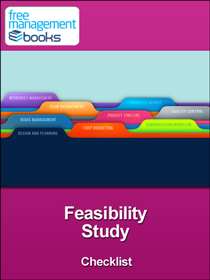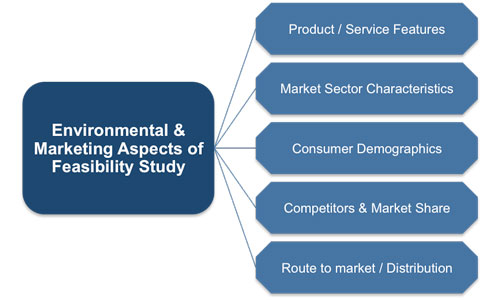Project Feasibility Study Checklist
 |
||
 |
||
This project feasibility study checklist enables you to produce a well-researched feasibility study that allows senior management, stakeholders and the project sponsor to give their approval for a project. It guides you through evaluating alternatives, market potential, cost effectiveness and technical solutions for your project.
The purpose of your project feasibility study is to evaluate possible alternatives, technical solutions, cost effectiveness and market potential. Our checklist will enable you to construct a well-researched feasibility study that enables your project sponsor, stakeholders and senior management to make an informed decision on whether to proceed with your project or not.
The section that will be critical to these people making an informed decision is your management summary, which is the first section of the study. This is often the last thing to be written because it draws all the project information together at a high-level defining the benefits for your organization on its completion. It also provides the key driving forces that have instigated the necessity for the project.
![]()
![]()
The study must include preliminary cost estimates and resources estimates, as well as an assessment of your organization's in-house capabilities. In your feasibility study you will propose the initial project objective. Some organization's requires project managers to produce a feasibility study at the end of each project phase; others prefer to have one study produced for the whole project.
The sections recommend for your project feasibility study are:
• Executive Summary
• Organizational Purpose & Benefits
• Issues related to Technology Factors
• Environmental Considerations
• Marketing Strategy
• Operational Considerations
• Implementation & Timeframes
• Financial Projections
• Recommendations
Depending on your own background you may need to bring in experts in a particular field to help you write these sections, such as, marketing strategy and financial projections etc.
Firstly you need to provide a description of your product or service and then describe at a high-level how your project, on its completion, will benefit the organization. The details described in this section are then applied to the following sections within your feasibility study document.
A key component of your study will be the technical considerations any new initiative requires so that benefits can be realized in a cost efficient and profitable manner.
In this section you provide a reasoned argument for developing the required skills. This may be satisfied internally or require you to use contractors for this activity and outlined in your preliminary development plan along with high-level costs associated with technical aspects of your project. You will also be required to identify and quantify potential weaknesses and issues that require further investigation.
 |
The next two sections are all to do with the marketing aspects of the project. Firstly you describe your market characteristics including the current product or service market environment, distribution, competitor analysis and consumer behavior. Extensive research data is required whether diversifying into a new market niche or entering an entirely new sector so that an informed decision can be made.
This section is followed by an explanation of how your projects completion assists your organization's marketing strategy. It defines the high-level benefits that could be achieved as a result of the project, for example strengthen its market position.
It also describes the main target audience and how your organization will be able to utilize different marketing techniques. Illustrations of estimated levels of return on any project investment and the likely length of competitive advantage that is attained as a result of the project are included.
As with all organizational initiatives there will be an impact on its operations, especially the human resources. The feasibility study needs to outline how the project will impact operating functions, both during and after your project. In many instances a project will alter current processes and procedures. These need to be defined at a high-level and any financial implications of the proposed changes need to be explained.
Some of these implications will be addressed and detailed in the Implementation & Timeframes section where you describe the high-level implementation framework that best suits your project objective. Once your project has been approved this framework is developed further during the planning stage.
Your schedule outlines the major events and milestones with dates for all your project phases. It also includes a breakdown of the tasks, their sequence and inter-relationships and leads into the next section of your study the financial aspects.
Within your feasibility study you need to provide financial projections and will need to involve experts in this are to help you compile the costs, expected investment returns and yields of your project. Common practice is to use 3 or 5 years projections. Within these projections you will outline any assumptions that have been made, along with the level of financial risk your project poises to your organization.
This leads you to the final section where you outline your findings and recommendations. In this section you present the key arguments - for and against - along with the justifications for why the project should be accepted. It is in this section that you define your projects likelihood of success and any assumptions you have made to arrive at this point.


